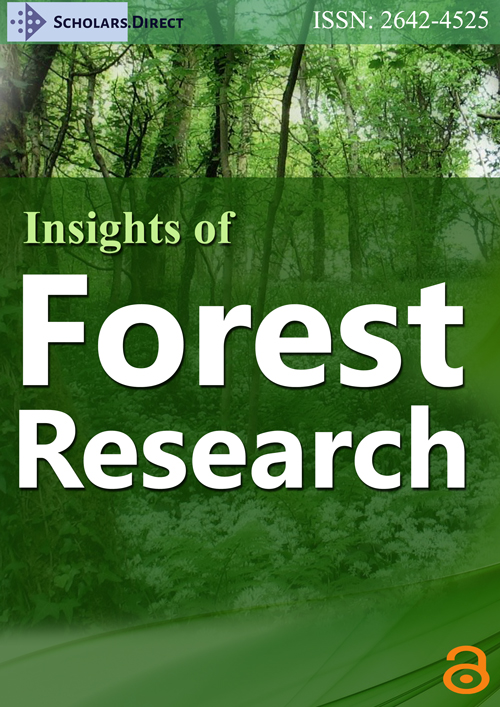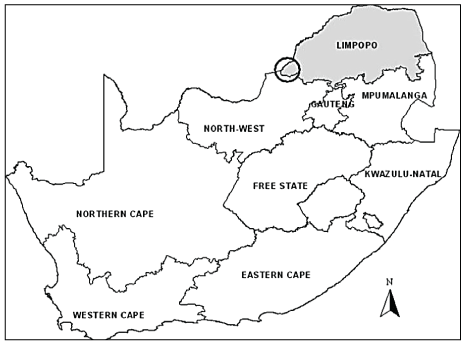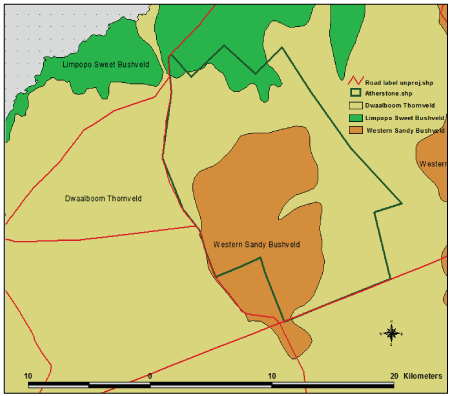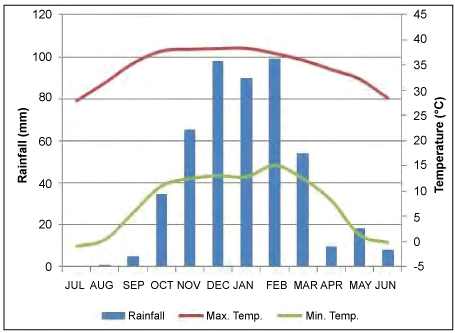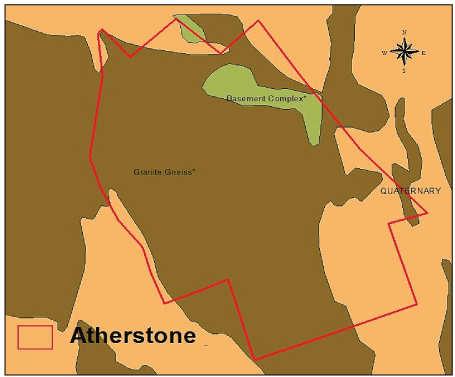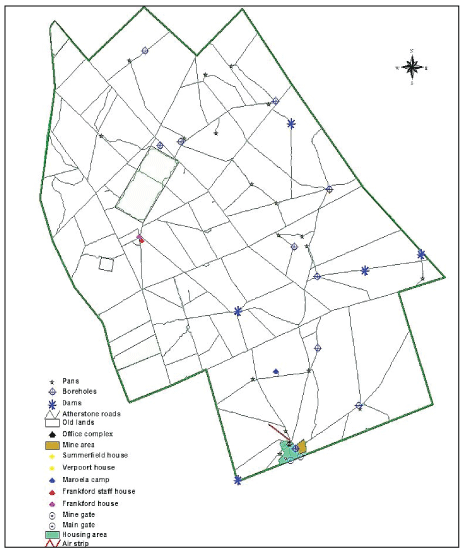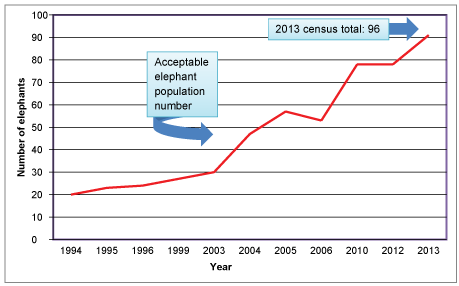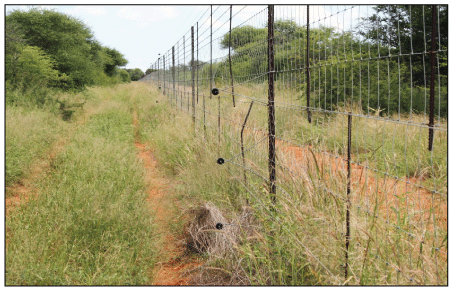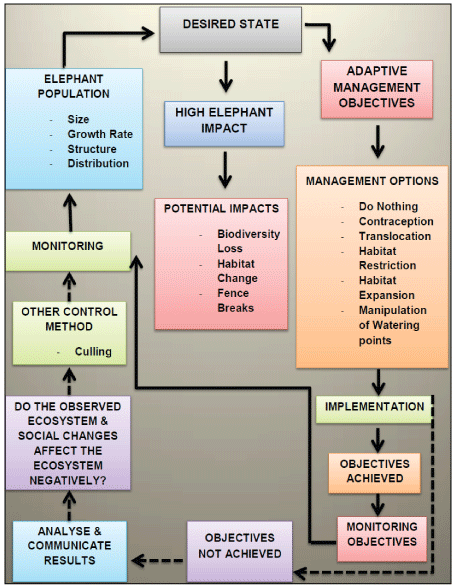Elephant Management Plan Outputs
Abstract
The African elephant is listed as a Protected Species in the list of Threatened or Protected Species. The interaction between elephants and trees in African savannas has become an active debate between scientists and managers as a result of ecosystem regulation. The study aimed at investigating the interactions between elephants and vegetation; assess the long-term impact of elephant damage on selected vegetation types, and extent of damage on certain species for browse, such as Sclerocarya birrea. The study was conducted at the Atherstone Collaborative Nature Reserve. Two different survey methods were applied. Vegetation plots set up along permanent transects were sampled for any impact resulting from the utilization by the study has unveiled three unusual phenomena within Marula populations; these included: (a) Adult mortality rates of up to 1% per annum; (b) The ‘missing size classes’ (between 0.5 and 10 m in height) and (c) Low/No recruitment rates. Due to the fact that no regeneration of Marula trees is evident, the current generation of Marula trees is under severe pressure from a too large population of elephants. To prevent the extinction of Marula trees in the reserve, it is imperative that the reduction of the elephant population be addressed. Management decisions affecting elephants on ACNR depended on five main focus areas; the habitat, elephant population, relevant infrastructure and equipment, safety and security issues, stakeholder involvement and buy-in.
Keywords
Elephant, Habitat, Management, Protected area, Vegetation
Introduction
The African savanna elephant (Loxodonta africana Blumenbach) is a generalist herbivore relying on widely distributed resources [1]. No species, other than man, can modify habitats as rapidly and extensively as elephants. The primary environmental factor affecting local elephant density is distance to water [2] with herds staying closer than 10 km from permanent water, on average, during the dry season [3]. Elephants at high densities strongly modify vegetation structure, converting woodland to shrub land [4], with subsequent modifications in plant and animal species composition [5]. Elephants mainly affect vegetation structure during the dry season, when they are predominantly browsers [6], and these effects increase with higher elephant densities [7].
The National Environmental Management: Protected Areas Act, 2003 (NEMPAA) [8] places emphasis on adaptive management. This section thus incorporates monitoring concepts required for understanding elephant management. Of relevance is Section 39 of NEMPAA, which deals with the preparation of management plans for protected areas. It specifically indicates that a management plan for a protected area should at least contain a coordinated policy framework, planning measures, controls and performance criteria, a program for its implementation and its costing, procedures for public participation, and the implementation of community-based natural resource management, as well as a zoning of the area indicating what activities may take place in different sections of the protected area as set out in Section 41(2) of NEMPAA.
The National Environmental Management: Biodiversity Act, 2004 (NEMBA) provides for the management and conservation of South Africa’s biodiversity within the framework of the National Environmental Management Act, 1998 (Act No.107 of 1998; NEMA) [9]. Section 43 of NEMBA provides that any person, organisation or organ of state desiring to contribute to biodiversity management may submit to the Minister for his or her approval, a draft management plan for an indigenous species listed in section 56 of the NEMBA or an indigenous species not listed, but that warrant special conservation attention.
NEMBA furthermore provides for the listing of threatened or protected species in terms of Section 56 (1) of the Act. Permits are required to carry out restricted activities involving listed threatened or protected species. This elephant management plan is not a formal Biodiversity Management Plan for a specific species as prescribed by the Biodiversity Act, 2004 (Act No. 10 of 2004). It is a requirement in terms of the National Norms and Standards for the Management of Elephants in South Africa (GN 251/GG 30833/29 February 2008) that most likely will have the same effect as a Biodiversity Management Plan.
In this study, management aspects of Loxodonta africana in the ACNR were explored, including elephant diet composition and preference and the impact of browsing on Marula trees. The study aimed at investigating the interactions between elephants and vegetation; assess the long-term impact of elephant damage on selected vegetation types. The objectives of the study were to investigate elephant damage on Sclerocarya birrea, document the long term influence of elephants on the vegetation composition and structure and construct management recommendations for the ACNR. It is recognised that this study represents a “snap-shot” into the management of elephants in the savanna biome. The findings of this study provide valuable baseline data to build future research on, and acts as a starting point for the introduction of adaptive management principles.
Study Area
The Atherstone Collaborative Nature Reserve (24°34.491’S and 26°47.11’E) is situated in the Thabazimbi District of the Limpopo Province’s Bushveld Region in South Africa (Figure 1). The reserve covers an area of approximately of 22688,163 hectares [10].
Flora
Vegetation
The ACNR is situated in the Savanna Biome of South Africa, in the central Bushveld Region [11]. Vegetation and landscape features vary from tall open woodland to low woodland. Broad-leaved and prominent microphyllous tree species, such as Acacia nilotica (L.) Wild. ex Del. and Acacia tortilis (Forssk.) are prominent [12]. Dominant tree species include Acacia erubescens (Welw. ex Oliver) on flat areas, Combretum apiculatum (Sond.) on shallow soils of gravelly upland sites, and Terminalia sericea (Burch. ex DC) on deep sands. The high palatability of the graminoid composition makes this central Bushveld vegetation highly suitable for game farming [12].
Atherstone Collaborative Nature Reserve lies in the Central Bushveld Regions comprising the Limpopo Sweet Bushveld (SVcb19), Western Sandy Bushveld (SVcb16) and Dwaalboom Thornveld (SVcb1) (Figure 2). The most dominant Vegetation Unit is the Dwaalboom Thornveld (SVcb1), which is dominating the north, eastern and south-eastern parts of the reserve [12]. Dwaalboom Thornveld occurs on plains, characterised by scattered, low to medium high, deciduous microphyllous trees and shrubs, with few broad-leaved tree species. An almost continuous herbaceous layer, which is dominated by grass species, occurs beneath the tree and shrub layer. Acacia tortilis and A. nilotica are very prominent on medium clayey soils. On particularly heavy clays, most other woody plants are excluded and the diminutive A. tenuispina, at a height of less than 1 m, dominates. On the sandy clay loam soils A. erubescens is the most dominant tree species. The alternation of these soil types creates patch mosaics approximately 1 to 5 km across [13].
The second most dominant Vegetation Unit being the Western Sandy Bushveld, occurring predominantly in the central and south-western areas. Western Sandy Bushveld varies from tall open woodland to low woodland with broad-leaved and microphyllous tree species being prominent [12]. The Vegetation Unit was further divided into Mixed Bushveld and Turf Thornveld [14], in an area that was classified by Pauw [15] as Grewia bicolor-Combretum apiculatum Short Open Tree Veld. This veld type was again was reclassified in 2004 by De Klerk [16] as Red Bushwillow-veld (this is further explained in chapter 3). Dominant tree species include A. erubescens on flat areas, Combretum apiculatum on shallow soils of gravelly upland sites and Terminalia sericea on deep sands. Other tree and shrub species include; Acacia erioloba (E. Mey.), A. nigrescens and Sclerocarya birrea (tall trees); A. mellifera subsp. detinens, A. nilotica and Combretum zeyheri (small trees); C. hereroense, Euclea undulata and Coptosperma supra-axillare (tall shrubs); and Clerodendrum ternatum, Indigofera filipes and Justicia flava (low shrubs). The field layer comprises grass species such as Anthephora pubescens, Digitaria eriantha subsp. eriantha, Eragrostis pallens, E. rigidior and Schmidtia pappophoroides. Herbs that occur in the vegetation include; Blepharis integrifolia, Chamaecrista absus, Evolvulus alsinoides and Geigeria burkei [12].
The most northern section of the reserve is dominated by Limpopo Sweet Bushveld [12]. The Limpopo Sweet Bushveld vegetation type extends from the lower reaches of the Crocodile and Marico Rivers down the Limpopo River Valley. This vegetation type is short, open woodland dominated by Acacia mellifera ((Vahl) Benth.) and Dichrostachys cinerea (L.) Wight & Arn., as well as taller tree species such as A. burkei (Benth.), A. robusta (Burch.) and Terminalia sericea (Burch. ex DC.), A. erubescens, A. nilotica, Albizia anthelmintica ((A.Rich.) Bronyn.), Cataphractes alexandri, Ehretia rigida (Thunb. Druce), Grewia flava (DC.), Acacia tenuispina and Gossypium herbaceum subspecies africanum. Graminoid and herbaceous species found in this vegetation unit include; Digitaria eriantha, Enneapogon cenchroides (Licht. ex (Roem. & Schult.) C.E. Hubb.), Panicum coloratum (L.), Harpagophytum procumbens (Burch.) DC. ex Meisn.), Indigofera daleoides (Benth. ex Harv.), Kleinia fulgens (Hook. F.) and Plectranthus neochilus (Schltr.) [12].
Plant communities
The Stipagrostis uniplumis - Terminalia sericea short open treeveld
The soil is generally deep and sandy; these soils are generally less fertile more leached than the soils of the rest of ACNR, and the grazing being less palatable and less attractive to game. The topography is flat to slightly sloping, except for the limited occurrence of drainage courses. This community is dominated by Terminalia sericea (Burch.), with Acacia tortillis (Forssk.), Dichrostachys cinerea (L.) Wight & Am.) and Grewia flava (DC.) also common. Other important species include; Acacia erioloba (E. Mey), Boscia albitrunca (Burch.) and Peltophorum africanum (Sond.). The woody layer has a rather shrubby structure, with a relatively high density of trees/shrubs lower than 1.5 m. Common grass species are Eragrostis lehmanniana (Nees), E. pallens and Stipagrostis uniplumis. Other less common species include Digitaria eriantha, Panicum maximum and Schmidtia pappophoroides (Licht. De Winter.) [16].
The Grewia bicolor - Combretum apiculatum short open treeveld
The soil is generally sandy to silt with a shallow gravely layer of the Cartref and Hutton soil forms. These soils are also generally not very fertile, but support more palatable grazing which are more attractive to game than the Sand Veld Unit. In the landscape of this vegetation, topography has slight elevations thus characterized by the more shallow and gravely soils. The most common tree and shrub species are A. burkei, Combretum apiculatum, C. hereroense (Schinz Illust.), Euclea undulata (Thunb) and Grewia bicolor (Juss.). The other conspicuous species are A. erubescens (Welw. Ex Oliver), A. tortillis and G. flava. Common grass species include; Aristida congesta (Roem. & Schult.), E. rigidior and P. maximum [16].
The Grewia flava - Acacia erubescens short open treeveld
This community occurs in predominantly deep Hutton soil forms with some deep Clovelly soils as well. The soils are generally rather fertile and productive and tend to carry very palatable grazing. The topography is very flat; except for the limited occurrence of drainage courses. The other species that spread throughout the community are Acacia fleckii (Schinz.), Boscia albitrunca and Ziziphus mucronata (Wild.). Common grass species in this community include Aristida congesta (Roem.), Panicum maximum, Tragus berteroniamus (Scult.), with a diversity of forbs also occurring in this unit. The habitat qualities are classified as a Sweet veld [16].
The Cymbopogon validus - Acacia nilotica short open treeveld
This vegetation is classified as a wide ecotone from the sandy and silty red soils areas to the turf veld. These are the clay rich Valsrivier and Hutton soil forms. The soils of the unit are rather productive and tend to carry very palatable grazing, which are very popular with game. The topography is very flat, except for the limited occurrence of drainage courses. The most common tree species in this community are A. nilotica, A. robusta (Burch.), with Acacia senegal var. rostrata (Wild.) and A. tortillis, also common. Grass species in this community are Cymbopogon validus (Stapf) Stapf ex Burtt Davy, Setaria verticillata (L.) P. Beauv., and Urochloa mossambicensis (Hack.) Dandy. The community qualities are classified as Sweet veld [16].
The Ischaemum afrum - Acacia tenuispina low open treeveld
The soil is almost entirely clay of the Acardia soil form, consisting of rich, fertile black turf. Red Hutton soils are primarily towards the ecotone. Soils in the drainage lines are also of the Arcardia form, although the Rensburg forms are also present in and along some of the drainage courses. Localized soils of the Katspruit form also occur. All soils of this community are very productive and carry highly palatable grazing. The topography is very flat, except for the limited occurrence of drainage courses. Diagnostic tree species in this community is Acacia tenuspina (I. Verd), with other conspicuous species being A. nilotica, A. tortillis and Dichrostachys cinerea (Wight & Arm.). The diagnostic grass species are Dinebra retroflexa (Vahl. Panz.), Eragrostis curvula (Schrad.) Nees), Ischaemum afrum (J.F. Gmel. Dandy) and Setaria incrassate ((Hochst.) Hack.). The presence of various forbs characterizes the community. With the community being Very Sweet Veld, a high production of potentially excessively palatable grazing grass led to overgrazing that adversely affected the veld condition, which lead to the disappearance of some palatable species [16].
Sensitive species
The sensitivity of species can be interpreted in a number of ways. For the purposes of this document it is assumed that sensitive species refer to taxons that are sensitive in terms of the impact or influence of elephant on them. Sclerocarya birrea trees are especially very sensitive to elephant impact, and virtually all large (> 5 m) trees have been destroyed by elephant activity [17]. Raptors such as Bateleur (Terathopius ecaudatus (Dudin), Martial Eagle (Polemaetus bellicosus Dudin), Tawny Eagle (Aquila rapax (Temminck)), Wahlberg’s Eagle (Aquila wahlbergi (Sundeval), as well as the White-backed Vulture (Gyps africanus Salvadori) nest in tall trees (such as Acacia nigrescens, Combretum imberbe and S. birrea). Breeding can adversely be affected if nesting trees become limited due to elephant’s impact on such trees [18].
Disturbed or degraded areas
The extent of disturbed and degraded areas within the ACNR is not fully mapped and recorded. These areas are mostly limited to an old agricultural field on the farm and areas that have problems with bush encroachment, specifically with species such as Acacia erubescens and Dichrostachys cinerea [19]. Previous attempts of bush clearing (1997-1999) mainly focused along roads in the reserve to improve game viewing. Controlled fire has also been used from 1998 to 2001 to address bush encroachment [16]. Similar management actions proved to be very successful in Namibia, but unfortunately no such actions have been undertaken in the last 10 years, resulting in severe encroachment problems.
Fauna
The Atherstone Collaborative Nature Reserve caters for a number of mammal species, presented in Table 1. A number of mammals occur in the ACNR. A total of 3508 head of mammals were counted at the ACNR in October 2013; ten mammal species were classified as grazers, six as mixed feeders and four as browsers. The results of the game count are provided in Table 2, Comparative results of game counts conducted in previous years since 2003 are represented by Table 3 [20].
Meteorology
Rainfall
The reserve lies in the summer rainfall zone with wet summers and dry winters. The climate can be described as hot, relatively dry climate with an unstable seasonal rainfall. The rainfall occurs mainly in summer, with very dry winters. Average annual precipitation for the period 1932-1985 is 505 mm, with the highest rainfall 986 mm recorded in 2000 and the lowest (160 mm) in 1935. Thunderstorms often occur in the late afternoons from November to March. Within the reserve, mean annual precipitation varies from about 450 mm in the north to about 650 mm in the south [21]. Hail does occur often during the summer months. No snow has been recorded, but a type of ice rain has occurred on the odd occasion [22]. The area receives an average of nine hours of sunshine per day [16].
Temperature
The mean monthly maximum and minimum temperature for Thabazimbi is 36.0 ℃ and -3.7 ℃ for February and June, respectively. The winters are temperate with cool nights, while the summer temperatures in the low-lying areas are high to very high. The September - April average temperature range is 27-36 ℃ (max) and 9-20 ℃ (min). The May - August average range is 21-24 ℃ (max) and 4-8 ℃ (min) [12]. The monthly average for maximum temperatures at the reserve ranges from 28 ℃ in July to 38 ℃ in January.
There is frequent light frost in winter. Frost can be expected on one or two occasions per year during winter, with the period of September to May being frost-free. Frost does occur and the region is coldest in June, when temperatures can drop to -1 ℃ at night (Figure 3) [13].
Geography
Topography
The ACNR is a very flat and level landscape, with no hills or mountains. It is located on slightly undulating plains from Assen northwards past Thabazimbi, which forms part of the Limpopo River Plains, mostly at altitudes of 900-1200 m above sea level. A slope of approximately 75 m occurs over a distance of 25 km. The uniformity of the topography of the reserve leads to little climate variation within the reserve [13].
Geology
Kruger (2013) noted that the ACNR is underlain by among others granites and gneiss of Zwazian Erathem, which lies under most of the central, western and southern areas of the reserve (Figure 4). The second most common geological type are Quaternary material that dominate in the eastern and south-eastern areas, and which consist of a complex of black turf with some calcrete and areas consisting of alluvium (water-transported material). The northern most extremes consist of Kalahari sand of the Ecca- and Kalahari groups. Northeast of the central areas of Atherstone a mixture of migmatite, gneiss, ultramorphic rocks, amphibolites, sour lavas and sedimentary rocks, of the Basement Complex are found [19].
Geology of the reserve has a marked influence on the vegetation of the reserve, through the soil types that typically formed from each of the geological types. The Kalahari sand consists of deep sandy soils, the granites and gneiss generally weathered into shallow, somewhat sandy, gravelly soils and some red Huttons soil forms. Atherstone Collaborative Nature Reserve has a mixed geological group of migmatite, gneiss, while the rest generally weathered into red Hutton soils. The black turf is responsible for the turf-areas of the eastern extremes and the south eastern corner of the reserve [13].
Soil
A variety of soil forms occur in the ACNR and can generally be grouped according to Land Types. Soils in the northernmost areas are predominantly deep, red-coloured fine grained sandy loams with a low clay content (7-20%) in the topsoil and a mostly low (8-15%), but sometimes medium-low (15-25%) clay content in the deeper layers. The central northern area’s soils are deep, but a small percentage of shallow red-coloured sandy clay loams occur with a moderate to high clay content in the upper and deeper layers (20-50%). The central and south-western area’s soils are predominantly shallow to moderately deep (up to 1200 mm) red-coloured (sometimes yellowish-brown) medium to course grained sandy clay loams, with a low to moderately low clay content in the upper and deeper layers (20-24%). The eastern part of the reserve has moderately deep (600-1000 mm), black to sometimes dark red-coloured clay rich (40-50%) soils [13].
Available Water Bodies and Their Distribution
The Atherstone Collaborative Nature Reserve is surrounded by the Marico River in the North and Lenkwane River in the East. The ACNR drains in a north-westerly direction towards the Marico River, which flows past the western boundary of the reserve. The drainage system of the ANR forms part of the Limpopo River System. The topography of the ACNR causes water to flow slowly across its flat to gently undulating landscape along underdeveloped, periodic drainage courses. There are no threatened river systems running through the reserve [23]. In addition, there is no Fresh Water Ecosystem Priority Areas identified for this area. A total of 10 earth dams and eight boreholes (which are not currently (2014) in operation) are located within the ACNR (Figure 5) [13]. Natural surface water of the ACNR is limited to a few natural pans that have water in the wet season. The artificial water supply network at the ACNR is well-developed, but unfortunately not well-maintained. More than 90% of the areas within the reserve lie within 1.8 km from open water [16].
Management of the Atherstone Collaborative Nature Reserve
Preferred management density of elephants
According to Kruger [13], 20 elephant were introduced to the ACNR in 1994 from the Kruger National Park by the then Transvaal Provincial Administration’s (TPA’s) Division of Nature Conservation. The purpose of the introduction was to enhance the species diversity of the reserve and to create opportunities for eco-tourism and related activities. During the last 21 years this population has grown at an average annual rate of 7.8% (Figure 6). According to Delsink, et al. [21], elephants should not comprise more than 15% of the total herbivore biomass of an area. Based on a 2012 helicopter count, the elephant population comprised 17% of the total herbivore biomass for the reserve. Based on the 2013 figure of Kruger [13], the total stocking rate equates to 10.35 ha/LSU, with the stocking rate for the grazing component 14.14 ha/LSU, and the number of browser units at 6.19 BU/100 ha. For the ACNR a much lower portion ranging between 6% and 8% of the total biomass is recommended by LEDET [13].
The elephant population has not been controlled since their introduction in 1994. A few bulls have been hunted but not for purposes of population control, of which the exact take off numbers are unknown. Population densities must be managed to allow positive elephant associated ecological processes to take place whilst not impacting negatively on the overall biodiversity including sensitive components within the reserve (e.g. vulture nesting sites or sensitive vegetation). Elephant management must further take cognizance of the other elephant objectives, e.g. optimizing their value as a tourist attraction [21]. According to Kruger [13], population control is, however, urgently required to slow down the current growth rate of 7.8%, and to reduce the population in the long term to a more sustainable level. There is, however, increasing pressure from land owners with a stake in the ACNR to utilize some elephant for trophy hunting purposes.
Specifications of perimeter fence
According to Hayward and Kerley [24], containing wildlife by means of fencing can only serve one or a combination of three purposes which are mainly: reduced human-wildlife conflict (by reducing contact between the two); reduced disease transmission risk between wildlife and domestic animals; and increased security of a protected area. Given that dispersal is likely to be a key mechanism regulating elephant populations [25]; fencing may also enhance local population growth [26]. The reserve is fenced off with an electrified perimeter fence which is in a very poor condition (Figure 7). The current specifications include a total fence height of 2.4 m and made up of the following [13]: 1.8 Fully Galvanized 1374/6 CWI Big five Veldspan and three strands of fully galvanized double strand Motto 1.5 mm barb wire, placed above the Veldspan at 200 mm intervals increasing the height to 2.4 m.
Potential for Enlarging the Property
Tree damages tend to be more concentrated in small isolated protected areas where corridors and dispersal areas are blocked by human settlements. Other tree damage activities include agriculture and farming (Table 2) [27,28]. The existing private land that forms part of the original ACNR already proves that a partnership between a State-owned Nature Reserve and private land owners is feasible. According to the National Protected Area Expansion Strategy [29], the areas east of the reserve are important for future expansion purposes, which would include more areas of the Limpopo Central Bushveld in the provincial Protected Area Network. Expansion to the north, west and south is not recommended due to the road network in these areas [13].
Protected Areas
Protected areas, wildlife and biodiversity are global assets - thus all humans, including future generations, have some stake in the outcome of an elephant management policy review process. Society should therefore contribute to determining the values expressed in the vision and management of nature reserves. Decision-makers must take into account stakeholder views, not only about the goals of management, but also the ethics of the methods used and the manner in which they are applied. Elephants and their management are therefore of interest to a very wide range of stakeholders in addition to the managers of conservation areas. To ensure successful implementation of the plan, the ACNR need to collaborate with a variety of stakeholders. Participants to these planning identified individuals, institutions, groups, parties or states with interests in elephant conservation (both negative and positive). It involves the identification of the resource problem, its cause(s) and the development of management objectives.
All stakeholders such as private land owners and specialists (environmentalists), relevant departments, funding organizations and relevant Non-Governmental Organisation (NGO’s) need to be invited [30]. The list of stakeholders includes conservation organizations, NGOs, research and training institutions, Community-Based Organisations (CBOs), Animal rights groups, Scientists, ecologists and central and local governments. Others key stakeholders include the media, local human communities, religious institutions, politicians, and defence forces. This step helps in the generation of ideas on how the identified problems could be solved. A management plan needs to state the benefits sharing mechanism and a time management plan. This need to cover the social, economic, environmental and policy issues affecting the private landowners.
Management Options
Management objectives are clearly articulated descriptions of a measurable standard, desired state, and threshold value, amount of change, or envisaged trend that is strived required for a particular plant population or habitat. A management objective lacking one or more of these components is ambiguous [31]. Objectives are developed to describe the desired conditions, while management is designed to meet the objectives, or existing management is continued. Management is adopted or (changed) if objectives are not reached. The prevention of resource deterioration should be non-negotiable in any management system [32].
Do nothing (laissez faire)
This option is known as a laissez faire policy meaning, a policy of letting nature take its own course, this allows for natural population fluctuations, and has been adopted by countries such as Kenya in recent decades. It has also been the policy implemented by default for South Africa’s national parks since 1995.
Rationale
Elephant population growth rate will decrease in response to decreasing resource availability within the reserve before irreversible or unacceptable habitat change results.
Advantages
Not acting will mean avoiding an immediate decision and thus the potential negative reactions resulting from more active management approaches.
Limitations to effectiveness
Risk of loss of biodiversity if no natural limitation of populations occurs..
Concerns
Habitat degradation and starvation may be more traumatic for elephants than culling.
Do nothing (laissez faire)
Elephant contraception has been tested in South Africa -immune-contraception. Immune-contraception is regarded as the most effective means of controlling elephant populations using reproductive control measures as it is safe, reliable, effective, easily administered and reversible [33]. The primary objective for a contraceptive program will be to manage the growth rate of the population by simulating natural disturbance cycles; thus it will promote an indefinite period of zero growth. Additional objectives and desired outcomes of population management must be clearly articulated to allow for long term adaptive management. A robust monitoring program must furthermore be developed to track management interventions [34].
Rationale
Limiting elephant reproduction by preventing conception will prevent population from increasing and could even reduce the population over the long term.
Advantages
Economically viable, could attract international sponsorship.
• Vaccine locally manufactured.
• Contraceptive use aims to control the elephant population without the killing of animals that so many find objectionable. It also holds the promise of being reversible.
• Ideally, contraception should be applied to some, but not all, females as a means of reducing breeding, while still maintaining a full age distribution within the herd.
• The contraceptive programme could be stopped and the population could recover quickly.
Limitations to effectiveness
Incapable of reducing population size in the short term.
• The efforts needed to stabilise elephant numbers in large populations through birth control are not realistic.
• The vaccines must be applied regularly, and should be applied by darting from helicopters because darting from game vehicles leads to elephant avoidance of game vehicles [22]. Hiring helicopters on a regular basis means contraception via pZP may be cost prohibitive to reserve managers.
• To effectively maintain zero growth contraception would need to be ongoing.
• Treated cows need to be marked individually in order to locate them for booster treatment. Most African countries do not have the finances or infrastructures to sustain such operations in the long term [35].
• It is there for a mutual understanding to agree with Bertschinger, et al. [36] who concluded that immune-contraception is only suitable for small, confined populations.
Concerns
There is currently insufficient historical data on the method’s effectiveness, reversibility, and long-term impacts on health and social behaviour of cows.
• Preventing births will destabilise the age structure of breeding herds.
• There will be a loss of genetic diversity over time.
• There could be impacts on the social behaviour and well-being of the cows and herds.
• Ethical concerns due to the level of interference in natural processes and elephants’ natural lives, particularly the right to reproduce.
Translocation
The techniques of capturing, immobilizing, transporting (to less populated areas) and releasing elephants into new environments have been developed in South Africa to the point where elephant mortality is low and the procedure is done safely in respect of elephant. The removal of intact viable family groups of elephants through translocation is recommended where elephant numbers are to be reduced as a short term objective [34].
Rationale
Translocation reduces local elephant densities by removing elephants from an area of high density to establish new populations.
Advantages
Translocation will increase existing populations in new elephant conservation areas.
Limitations to effectiveness
Translocation of elephants is extremely costly and as many reserves are already saturated with elephants, it is not always easy to find a reserve willing to accept new elephants, at least not in large numbers. More importantly, few existing conservation areas in southern Africa can accommodate extra elephants [37].
• In addition, according to the National Environment Management Biodiversity Act of 2004: National norms and standards for the management of elephants in South Africa, elephants should not be translocated more than once.
Concerns
Capture and transfer process, and removal from familiar social and physical environment, is stressful for elephants.
Selective culling of elephants
Culling should be the management action of last resort and can only be followed once all other management actions have been investigated and proven to be unsuccessful and or where interventions are urgent. Only if translocation is unsuccessful could selective culling of individual bulls, and specific herds to reduce the overall population to within the recommended guidelines, be followed [34]. However, an important point is that culling programme will not prevent the disappearance of mature Marula trees from the ACNR. Elephants will still have an impact on their favored plant species, even at low densities. Culling can therefore not be seen as a way of prevention measure for elephants in selecting for favored species, but merely an attempt to slow the process down.
Rationale
Disturbance events, like culling, are the third management action that can potentially influence elephant distribution and dispersion patterns [38].
Advantages
Only option that is currently available to reduce the population in the short term.
• Sale of by-products can finance costs of management.
• Potential for economic benefits to local communities from consumptive use and employment in the processing of by-products.
Limitations to effectiveness
Although culling should be used with caution, it is unlikely to result in the same disastrous consequences of widespread culling in Kruger National Park in the late 1990s if entire family units are removed, leaving non relatives of the culled elephants behind [39].
• Random culling can increase group size, ultimately causing more damage (e.g. 500 elephants utilizing an area over 10 days can have much greater impacts, than 50 elephants over 100 days; Laws, et al., 1970) [40].
Concerns
Ethical concerns for animal welfare and animal rights.
• Potentially traumatic for entire populations.
• Removal of entire family groups removes older females from the population over time causing a loss of cultural information and disruption of social networks.
Fencing off sensitive areas
Once elephant density is reduced (either by range expansion or population reduction), then elephant access to areas of the reserve that are heavily impacted by browsing could be temporarily restricted to give plants time to recover. As high densities of elephants in fenced reserves can lead to permanent, negative impact on vegetation [41], elephant population control is a necessary part of game reserve management. An issue of concern is the potential impact of elephants on tall trees and the repercussions for nesting vultures. A possible solution may be to fence off the nesting clusters to prevent elephant access and utilization of nesting trees [34].
Rationale
This method has already been successfully used in Addo Elephant National Park, Tembe Elephant Park and Phinda Resource Reserve; where certain endemic plant species are now only being found in areas from which elephants have been excluded.
Advantages
Rare and threatened vegetation at high risk from elephant activities will be protected from any impacts of elephants by fencing.
Limitations to effectiveness
The expense of installing and maintaining fences, therefore most appropriate for small areas of highly threatened endemic vegetation.
• Potential loss of ecological benefits from presence of elephants and other wildlife.
Concerns
The practicality of implementing this action is, however, a concern as it would concentrate elephants onto a smaller area of land that may lead to new problems emerging.
• The distribution of nesting sites is also fairly wide, making it difficult to identify specific areas that can be fenced off [13].
Habitat expansion (Meta-population dynamics)
This means expanding the size of the reserve. Meta-population dynamics is a population management option which is more than just range expansion, but explicitly addresses how elephants should use space and resources that affects their dispersal behaviour and population dynamics.
Rationale
This will allow restoration of natural migration and dispersal processes which will enable elephant populations to limit their own density more effectively. One of the most important gradients is water availability.
Advantages
Compatible with a minimum interference conservation ethic as it mimics natural processes to limit populations.
• Provides opportunity for habitat regeneration if elephants leave for long periods.
Limitations to effectiveness
Success in limiting populations and impacts depends on a number of assumptions about elephant movements and habitat preferences.
Concerns
It remains unknown as to whether elephants will occupy the new areas.
Manipulation of watering points
Spatio-temporal patterning in elephant dispersion can be encouraged by rotating or reducing additional water [42] and carefully considering the location of such water sources [43]. As stated in chapter 2, section 7, there are too many artificial water points at the ACNR. It is therefore recommended that, access to the water points in the ACNR be rotated in order to minimize the level of degradation around water points. It is recommended that the mineral supplements (salt licks) be provided throughout the Reserve, and not just at the watering points, but also where there are a threatened species. This will result in reduced residence time at the watering points and threatened species area by water-dependent large herbivores.
Rationale
When taking this decision, the size of the reserve and the map indicating the watering point’s distribution should be used as guide.
Advantages
All year-round water supplies tend to allow movement between distinct wet and dry season ranges - this seasonal migration will give relief to vegetation from the impacts of high elephant densities.
Limitations to effectiveness
Water provision system as proposed by Thrash [44], to be adopted, though the distance to those watering points could negatively affect other fauna in the reserve.
Concerns
Removing many of the artificial water sources will limit elephant foraging range in the dry season and could limit the extent of impacts on susceptible tree species.
Building a Goal-Orientated Adaptive Approach
An adaptive approach is mandated by the norms and standards for elephant management [45], certainly at the property or park level. Conservation of threatened plant species relies on four adaptive management tools to effectively conserve such species: a) Objectives are developed to describe the desired conditions or outcomes, b) Management is designed to meet the objectives, c) The response of the resource is monitored to determine if the objective(s) has/ve been met, and d) Management is adapted or (changed) if objectives are met or not [46]. The goal of management in any discipline is to control the components of any system under consideration. An adaptive management program involves setting specific economic and biological objectives, and continuously monitoring progress, while recording relevant management actions and environmental change [47]. Any change in the condition of the vegetation can then be related back to the management applied and/or the environmental conditions experienced.
Adaptive Management
This stage involves detecting and measuring changes in the biodiversity and to evaluate the successes and failures of strategies [48]. Observation to see what precipitated the current vegetation state is fundamental. The desired state of vegetation needs to be determined together with the level of change that will be tolerated. Objectives are developed to describe the desired conditions, while management is designed to meet the objectives, or existing management is continued. The response of the resource is monitored to determine if the objectives have been met. Management is adopted or changed if objectives are not reached [46].
Although the present study detected massive effects of elephants at the ACNR, it is expected that the effects of their feeding will be cumulative and monitoring must continue. Monitor animal population numbers and structures: an important and vital part of any management programme in determination of population trends [49]. Wildlife counts done on regular bases at least once a year, these counts should be repeatable, and give the same estimate for the same number of fauna each time it is conducted. Natural mortality rate should be determined annually, including the reason for death. The control of elephant numbers must be implemented to prevent further deterioration of this important vegetation. Decisions on managing elephants are dependent on stated land use objectives, the techniques by which this can be practically achieved being situation-specific. Five main focus areas; were the habitat, elephant population, relevant infrastructure and equipment, safety and security issues, stakeholder involvement and agreement. Influential factors are the size of the area involved (24,000 hectares); conservation value of the elephant population; biodiversity of the area. The effective elephant management plan, that is desirable, is the one that is differentiated and evolving best practice guideline for various circumstances is achievable. Management tools are limited, but configuration of reducing the number and water supply manipulation provides a starting template. Exclusion plots in the evaluating the effects of elephants, other herbivores, and climate on the woody vegetation dynamic should be an integral element of an adaptive management strategy (Figure 8).
Proposed Recovery Plan for Sclerocarya Birrea
It has been suggested to use artificial gene flow as a conservation measure. For instance, seeds from one large and vigorous population could be brought to a small and endangered population, hereby increasing its genetic diversity. The demography of S. birrea at the ACNR could be also be increased by re-stocking the population with plants from other populations (augmentation) (e.g. 100 individual seedlings of S. birrea that is can be grown in a growth room). The distance between the transplanted individuals is suggested to be between 15 m and 20 m, considering the crown diameters documented in chapter 4. An important issue raised by these findings is the process by which Marula can be re-established through anthropogenic re-establishment during the rainy season. However, to support seedling recruitment processes and population persistence, long-term commitment to their management is essential [50].
Marula trees can be secured for the time being by surrounding them with stones, so that they cannot be used by elephants. Restricting the presence of elephant bulls where Marula trees are prevalent, during the dry season will assist in reducing damage to Marula trees. Wet season grazing pressure in the other regions, will leave dominant vegetation locally threatened if elephants concentrate their impacts disproportionately in these patches (e.g. around the sites that used to be farms, where only grass is abundant).
Monitoring vegetation plots
Accurate monitoring techniques are vital in order for managers to be pro-active and adapt their management before irreversible damage occurs. Monitoring must be repeatable [51]. Monitoring must also incorporate the non-woody component to detect changes brought about by elephants grazing. Monitoring of the woody component of the vegetation could use the method employed in this study, which would ensure that future results are comparable with those presented in this dissertation. If this is monitored over a sufficiently long period, the ACNR could potentially predict changes in species composition and structure over the long time. The response of the resource is monitored to determine if the objectives have been met. It is recommended to establish permanent evaluation sites within each plant communities, together with the coordinates of the evaluation sites, onto vegetation map for future reference. The evaluation sites should be set out as transects, recording changes in species composition of the vegetation [52]. Should an obvious negative impact be discernible, such as the appearance of a browse line and a drop in the quantity of leaves, flowers/fruit and seedlings from one year to the next, browse stocking rates should be reassessed [53]. Fire management plan, drought (indicating dates and intensity) water provision, and control of bush encroachment should be implemented and documented.
Exclusion plots
Will provide valuable information in evaluating the effects of herbivores and climate on vegetation and should be an integral part of the monitoring system. To achieve this, a monitoring programme will need to be put into place that would not merely track changes but also look at causal effects by creating control areas which separate the effects of elephants from those of climatic variability, fire and other herbivores.
Fixed point photography
A cheap and reliable, easily applicable method of vegetation monitoring. Browse monitoring programmes could consist of fixed point photography sites containing key browse species [54] supplemented with quantitative monitoring techniques. These sites should be photographed and examined at the end of the dry season and during the peak flowering/seeding period [53]. A series of photographs must be taken from the same point at the same time every year. This will provide a visual reference point of the impact of various external influences on the vegetation, such as excessive grazing and fire practices [55].
If there are threats to serious or irreversible environmental damage, lack of full scientific certainty should not be used as a reason for postponing measures to prevent environmental degradation (Figure 9).
Researchers and Research Promotion
Researchers play a crucial role in the identification of resource problems at the most basic level and are able to suggest objective, scientific-based solutions. Researchers contribute to an enhanced understanding of management issues [56]. Researchers should attempt to incorporate a long-term scale in their studies.
Acknowledgements
We thank Limpopo Economic Development Environment and Tourism for making the ACNR available for this study, and we acknowledge their logistical assistance.
References
- Archie EA, Hollister-Smith JA, Poole JH, et al. (2007) Behavioural inbreeding avoidance in wild African elephants. Mol Ecol 16: 4138-4148.
- Van Aarde RJ, Grainger M, Whyte I (2005) Landscape heterogeneity and the use of space by elephants in the Kruger National Park, South Africa. African Journal of Ecology 43: 369-375.
- Stokke S, Du Toit JT (2002) Sexual segregation in habitat use by elephants in Chobe National Park, Botswana. African Journal of Ecology 40: 360-371.
- Augustine DJ, McNaughton SJ (2004) Regulation of shrub dynamics by native browsing ungulates on East African rangeland. Journal of Applied Ecology 1: 45-58.
- Landman M, Kerley GIH, Schoeman DS (2008) Relevance of elephant herbivory as a threat to important plants in the Addo Elephant National Park, South Africa. Journal of Zoology 274: 51-58.
- Scogings PF, Johansson T, Hjalten J, et al. (2012) Responses of woody vegetation to exclusion of large herbivores in semi-arid savannas. Austral Ecology 37: 56-66.
- Owen-Smith N, Kerley GIH, Page B, et al. (2006) A scientific perspective on the management of elephants in the Kruger National Park and elsewhere. South African Journal of Science 102: 389-394.
- (2003) National Environmental Management: Protected Areas Act 57 of 2003. To provide for a diverse and representative network of Protected areas on state land, private land, communal land and marine waters. Government Gazette 29674.
- To provide for co-operative, environmental governance by establishing principles for decision-making on matters affecting the environment, institutions that will promote co-operative governance and procedures for co-ordinating environmenhl functions exercised by organs of stite; and to provide for matters connected therewith. Government Gazette 19519.
- Pretorius Y, De Boer WF, Van Der Waal C, et al. (2011) Soil nutrient status determines how elephant utilize trees and shape environments. J Anim Ecol 80: 875-883.
- Mucina L, Rutherford MC (2011) The Vegetation of South Africa, Lesotho and Swaziland. Strelitzia 19. South African National Biodiversity Institute (SANBI), Pretoria.
- Mucina L, Rutherford MC (2006) The Vegetation of South Africa, Lesotho and Swaziland. Strelitzia 19. South African National Biodiversity Institute, Pretoria.
- Kruger JW (2013) Elephant Management Plan for Atherstone Nature Reserve (ANR) 2014-2018. Limpopo Department of Economic Development, Environment & Tourism (LEDET), Internal Report.
- Acocks JPH (1954) Veld Types of South Africa. (1st edn), Memoirs of the Botanical Survey of South Africa 7: 1-129.
- Pauw JC (1988) Guidelines for Wildlife Management in the Bushveld Communities of the Atherstone Nature Reserve in the Northwest Transvaal. Dissertation. University of Pretoria, Pretoria.
- De Klerk JN (2004) Bush Encroachment: in Namibia. Report on Phase 1 of the Bush Encroachment Research, Monitoring and Management Project. Ministry of Environment and Tourism, Government of the Republic of Namibia.
- Ferreira CNCH (2004) Elephant impact on Marula trees inside the Atherstone Nature Reserve. Limpopo, South Africa.
- Herremans M, Herremans-Tonnoeyr D (2000) Land use and the conservation status of raptors in Botswana. Biological Conservation 94: 31-41.
- Nel EJ, Kruger JW (2012) Scientific Review: State Owned Nature Reserves, Limpopo.
- Bassair A (2013) Game Count Report: Atherstone Nature Reserve-2013.
- Delsink AK, Van Altena JJ, Grobler D, et al. (2006) Regulation of a small, discrete African elephant population through immunocontraception in the Makalali Conservancy, Limpopo, South Africa. South African Journal of Science 102: 403-405.
- Delsink AK, Van Altena JJ, Grobler D, et al. (2007) Implementing immunocontraception in free-ranging African elephants at Makalali Conservancy. J S Afr Vet Assoc 78: 25-30.
- Nel P (2010) Southern African Wildlife Management Association (SAWMA). Proceedings of a Seminar. Challenges in the management of medium-sized conservation areas.
- Hayward M, Kerley G (2009) Fencing for conservation: restriction of evolutionary potential or a riposte to threatening processes? Biological Conservation 142: 1-13.
- Van Aarde RJ, Jackson TP, Ferreira SM (2006) Conservation science and elephant management in southern Africa. South African Journal of Science 102: 385-388.
- Robertson K (2013) Do Anthropogenic and Natural Features Act as Barriers to African Elephant (Loxodonta africana) Space Use? MSc Dissertation, University of the Witwatersrand, Johannesburg.
- Ngene SM, Van Gils H, Van Wieren SE, et al. (2009) The ranging patterns of elephants in Marsbit protected area, Kenya: The use of satellite-linked GPS collars. African Journal of Ecology 48: 386-400.
- Hema EM, Barnes RFW, Guenda W (2010) Distribution of savanna elephants (Loxodonta africana Blumenbach 1797) within Nazinga Game Ranch. Pachyderm 48: 33-40.
- Jackleman J, Holness S, Lechmere-Oertel R (2007) The national protected area expansion strategy 2008-2012: A framework for implementation. Compiled for the South African Biodiversity Institute (SANBI) and National Department of Environmental Affairs and Tourism (DEAT), Pretoria 93.
- Yeatman L (2004) Community-Based Natural Resource Management in the Communal Savannas of the Bushbuckridge Lowveld. In: Lawes MJ, Eeley HAC, Shackleton CM, Indigenous Forests and Woodlands in South Africa. Policy, People and Practice. University of KwaZulu-Natal Press, Scottsville, 671-678.
- Stuart-Hill GC (1993) Towards Formalized Adaptive Management: Vegetation Monitoring in South Africa. PhD. Thesis. University of Natal, Pietermaritzburg.
- Stuart-Hill GC (1989) Assessing the condition/ecological status of Valley Bushveld. In: Dankwertz JE, Teague WR, Veld Management in the Eastern Cape. Department of Agriculture & Water Supply (Eastern Cape Region), 103-108.
- Bertschinger H, Delsink A, Van Altena JJ, et al. (2008) Reproductive control of elephants. In: Scholes RJ, Mennell KG, Elephant Management: A Scientific Assessment of South Africa. Witwatersrand University Press, Johannesburg, 357-428.
- Delsink AK (2009) Elephant Management Plan - Atherstone Nature Reserve. Wildlife Management Solutions, Hoedspruit.
- Pimm SL, Van Aarde RJ, Fayrer-Hosken RA, et al. (2001) African elephants and contraception. Nature 9: 411-426.
- Bertschinger HJ, Kirkpatrick JF, Fayrer-Hosken RA, et al. (2003) Immunocontraception of African elephants using porcine zona pellucida vaccine. In: Proceedings of the First Workshop on the Control of Wild Elephant Populations. Utrecht University, Netherlands.
- Hofmeyr MV (2003) Spatial Demography of Selected Tree Species in the Kruger National Park, in Relation to Elephant Impacts. Progress Report of Research Committee Meeting. University of the Witwatersrand, South Africa.
- Whyte IJ, Biggs HC, Gaylard A, et al. (1999) A new policy for the management of the Kruger National Park’s elephant population. Koedoe 42: 111-132.
- Slotow R, Biggs HC, Scholes RJ, et al. (2008) Towards Integrated Decision-Making for Elephant Management. In: Scholes RJ, Mennell, KG, Assessment of South African Elephant Management. Witwatersrand University Press, Johannesburg, 530-578.
- Laws RM, Parker ISC, Johnstone RCB (1970) Elephants and habitats in North Bunyoro, Uganda. African Journal of Ecology 8: 163-180.
- Guldemond R, Van Aarde R (2008) A meta-analysis of the impact of African elephants on savanna vegetation. Journal of Wildlife Management 72: 892-899.
- Chamaille-Jammes S, Valeix M, Fritz H (2007) Managing heterogeneity in elephant distribution between elephant population density and surface water availability. Journal of Applied Ecology 44: 625-633.
- Smith RJ, Easton J, Nhancale BA, et al. (2008) Designing a transfrontier conservation landscape for the Maputaland centre of endemism using biodiversity, economic and threat data. Biological Conservation 141: 2127-2138.
- Thrash I (2000) Determinants of the extent of indigenous large herbivore impact on herbaceous vegetation at watering points in the north-eastern lowveld. South Africa, Journal of Arid Environments 44: 61-72.
- Department of Environmental Affairs and Tourism (DEAT) (2007) Draft National Norms and Standards for the Management of Elephants in South Africa. Department of Environment and Tourism, Government Gazette 29674.
- Elzinga CL, Salzer DW, Willoughby JW (1998) Measuring and monitoring: Plant Populations. Bureau of Land Management, Denver, Colorado.
- Biggs HC, Rogers KH (2003) An adaptive system to link science, monitoring and management in practice. In: Du Toit JT, Rogers KH, Biggs HC, The Kruger Experience: Ecology and Management of Savanna Heterogeneity. Island Press, London.
- Miller K, Allegretti MH, Johnson N, et al. (1995) Measure for Conservation of Biodiversity and Sustainable Use of its Components. In: Heywood VH, Watson RT, Global Biodiversity Assessment. Cambridge University Press, Britain, 915-1062.
- Bothma J Du P (1996) Game Ranch Management. (3rd edn), Van Schaik, Pretoria.
- Morgan JW (1999) Have tubestock plantings successfully established populations of rare grassland species into reintroduction sites in western Victoria? Biological Conservation 89: 235-243.
- Coetzee K (2005) Caring for Natural Rangelands. University of KwaZulu-Natal Press, Scottsville.
- Gaugris JY, Matthews WS, Van Rooyen MW, et al. (2004) The vegetation of the Tshanini Game Reserve and a comparison with equivalent units in the Tembe Elephant Park in Maputaland. South Africa, Koedoe 47: 9-29.
- Birnie RV, Tucker G, Fasham M (2005) Methods for Surveying Habitats. In: Hill D, Fasham M, Tucker G, et al. Handbook of Biodiversity Methods: Survey, Evaluation and Monitoring. Cambridge University Press, Cambridge.
- Hurt CR, Hardy MB (1989) A weighted key species method for monitoring change in vegetation composition. Journal of the Grassland Society of Southern Africa 6: 109-113.
- Bothma J Du P, Van Rooyen N (2003) Ecological Monitoring. Game Ranch Management. Van Schaik, Pretoria, 30-33.
- Von Maltitz GP, Shackleton SE (2004) Use and Management of Forests and Woodlands in South Africa: Stakeholders, Institutions and Processes from Past to Present. Indigenous Forests and Woodlands in South Africa: Policy, People and Practice. University of KwaZulu-Natal Press, Scottsville, 109-135.
- Marnewick K, Funston PJ, Karanth KU (2008) Evaluating camera trapping as a method for estimating cheetah abundance in ranching areas. South African Journal of Wildlife Research 38: 59-65.
Corresponding Author
MQ Seloana, Department of Biodiversity, University of Limpopo, Private Bag X1106, Sovenga, 0727, South Africa.
Copyright
© 2017 Seloana MQ, et al. This is an open-access article distributed under the terms of the Creative Commons Attribution License, which permits unrestricted use, distribution, and reproduction in any medium, provided the original author and source are credited.

